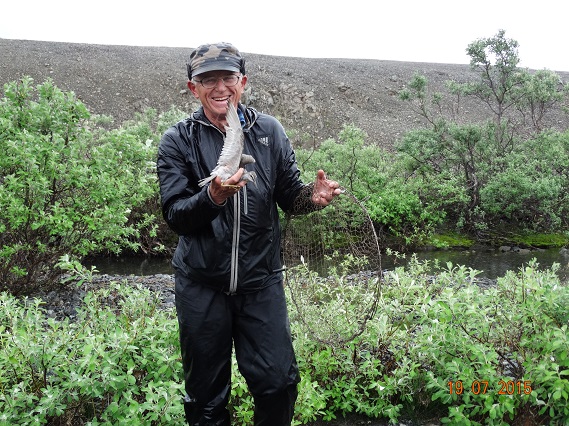by Spike Millington
Chief Executive of the EAAFP Secretariat
Pavel Tomkovich is one of the most experienced and respected scientists working on Arctic breeding birds, particularly shorebirds. In July 2015, I had the opportunity to accompany Pavel to a couple of field sites near Meinapilgino, just south of the Arctic circle in Chukotka, Russia. In addition to his excellent field skills, he is a demon quad bike driver – once he has his head down, hat on and goggles fixed, there is no terrain, be it mountain slopes, surging rivers or dense willow scrub that Pavel cannot negotiate. After the field trips, I sat down with Pavel and asked him a few questions.
S: How did your interest in the Arctic and its shorebirds first begin?
P: Well, my mother was a teacher of biology at my school, so maybe that had something to do with it! We had a Young Naturalists Club at school and I joined that. Later, I was a student at Moscow State University in the early 70s and Professor Vladimir Flint, himself a famous ornithologist and author of the Birds of Russia, invited me on an expedition to Yakutia, studying Pectoral and Sharp-tailed Sandpiper breeding behavior. After that, I was hooked. I joined the Moscow Ringing Center after graduating and in 1975-76 undertook expeditions to Chukotka, studying Red-necked Stints and I have been lucky to work as a scientist at the Moscow Zoological Museum since then.
S: What are you working on now?
P: Well, here in Meina, in addition to work on Spoon-billed Sandpipers, I am conducting long-term studies on the population of Red Knots (subspecies rogersi) just outside the village. This is probably the southernmost breeding population of Red Knot anywhere in the world. Geolocators have shown these birds are quite terrestrial, not using coastal wetland habitat until well into their migration. Of three birds tagged, 2 wintered in New Zealand and one in the Gulf of Carpentaria, in Australia. The birds then fly in a single journey to the main staging area in Bohai Bay, China on their return in the spring.
I also study a population of Tattlers, mostly Grey-tailed Tattlers but also a few Wandering Tattlers, that breed in the mountain river valleys about 40 kms, north of Meina. Flagged birds have been sighted in Japan and Queensland.
S: What changes have you seen in the Arctic in the last 40 years?
P: Since the break-up of the Soviet Union, the human population in the Arctic has decreased. This means there is less pressure on the Arctic, but also that it is more difficult to get around! Of course the Arctic is a huge area, so the pressures here are much less that at some of the critical migratory staging areas. But in some areas, proposals for mining (such as coal mining near Meina) still pose potential threats.
S: What about climate change?
P: Yes, of course. In the village of Beringovski, not far from here, there are now significant stretches of bushy areas, where there only used to be open tundra. Even in Meina we are seeing the first low scrub appear. The Russian sauna here can now offer birch branches as an additional attraction!
The warmer climate itself is largely beneficial for breeding birds – there are more insects to feed on, but there are risks of phenological mis-matches as arrival of birds may not coincide with optimal food resources. And ultimately, there is a threat to habitats. This is perhaps most obvious for a species like Spoon-billed Sandpiper, the global population of which requires very specific types of open, sparsely vegetated areas to breed. Invasion of low scrub would be disastrous for this species.
S: How do you see your responsibility as a research scientist to the conservation of Arctic breeding shorebirds?
P: What we can do is demonstrate what is happening the birds and through banding, flagging and geolocator studies, help identify critical areas important to the birds, many of which are of course under extreme pressure throughout the Flyway. Also we can try to understand how adaptable are the birds to the rapid changes we see going in the world around them, although I do fear that the scale and pace of change these days is such that the birds may not be able to adapt quickly enough.
One thing that we are seeing here in Chukotka is that breeding shorebirds that migrate inland using other flyways are doing okay, such as Ringed Plover, which may winter in the Persian Gulf, or Wood Sandpiper. It is those species dependent on coastal habitats in the East Asian – Australasian Flyway that are really in trouble, including our Red Knots! In addition, we are seeing expanding populations in Chukotka of breeding shorebirds from other flyways, such as Western Sandpiper, and recently Semi-palmated Sandpiper, which migrate through the Americas.
S: What are your plans for the future?
P: I may have to scale down some of my field activities as time goes on. I am currently working on the shorebirds sections of the upcoming Birds of Russia book. That alone could take ten years!
– Relevant article: Spike returned from three weeks in Chukotka, Russia





